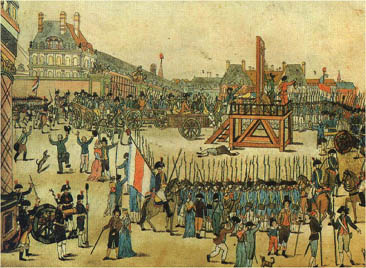Guillotine
Sensing the growing discontent, Louis XVI banned the use of the breaking wheel. In 1791, as the French  Revolution progressed, the National Assembly sought a new method to be used on all condemned people regardless of class. Their concerns contributed to the idea that capital punishment's purpose was the ending of life instead of the infliction of pain.
Revolution progressed, the National Assembly sought a new method to be used on all condemned people regardless of class. Their concerns contributed to the idea that capital punishment's purpose was the ending of life instead of the infliction of pain.
A committee was formed under Antoine Louis, physician to the King and Secretary to the Academy of Surgery.Joseph-Ignace Guillotin, a professor of anatomy at the facility of medicine in Paris, was also on the committee. The group was influenced by the Italian Mannaia (or Mannaja), the Scottish Maiden, and the Halifax Gibbet. While these prior instruments usually crushed the neck or used blunt force to take off a head, their device used a crescent blade and a lunette (a hinged two part yoke to immobilize the victim's neck). Laquiante, an officer of the Strasbourg criminal court, made a design for a beheading machine and employed Tobias Schmidt, a German engineer and harpsichord maker, to construct a prototype. Antoine Louis is also credited with the design of the prototype. An apocryphal story claims that King Louis XVI (an amateur locksmith) recommended a triangular blade with a beveled edge be used instead of a crescent blade, but it was Schmidt who suggested placing the blade at an oblique 45-degree angle and changing it from the curved blade. The first execution-by-guillotine was performed on highwayman Nicolas Jacques Pelletier[6] on April 25, 1792.
The basis for the machine's success was the belief that it was a humane form of execution, contrasting with the methods used in pre-revolutionary, Ancien Régime France. In France, before the guillotine, members of the nobility were beheaded with a sword or axe, while commoners were usually hanged, a form of death that could take minutes or longer. Other more gruesome methods of executions were also used, such as the wheel, burning at the stake, etc. In the case of decapitation, it also sometimes took repeated blows to sever the head completely, and it was also very likely for the condemned to slowly bleed to death from their wounds before the head could be severed. The condemned or the family of the condemned would sometimes pay the executioner to ensure that the blade was sharp in order to provide for a quick and relatively painless death.
The guillotine was thus perceived to deliver an immediate death without risk of suffocation. Furthermore, having only one method of execution was seen as an expression of equality among citizens. The guillotine was then the only legal execution method in France until the abolition of the death penalty in 1981, apart from certain crimes against the security of the state, which entailed execution by firing squad.
Sed lacus. Donec lectus. Nullam pretium nibh ut turpis. Nam bibendum. In nulla tortor, elementum ipsum. Proin imperdiet est. Phasellus dapibus semper urna. Pellentesque ornare, orci in felis. Donec ut ante. In id eros. Suspendisse lacus turpis, cursus egestas at sem.

